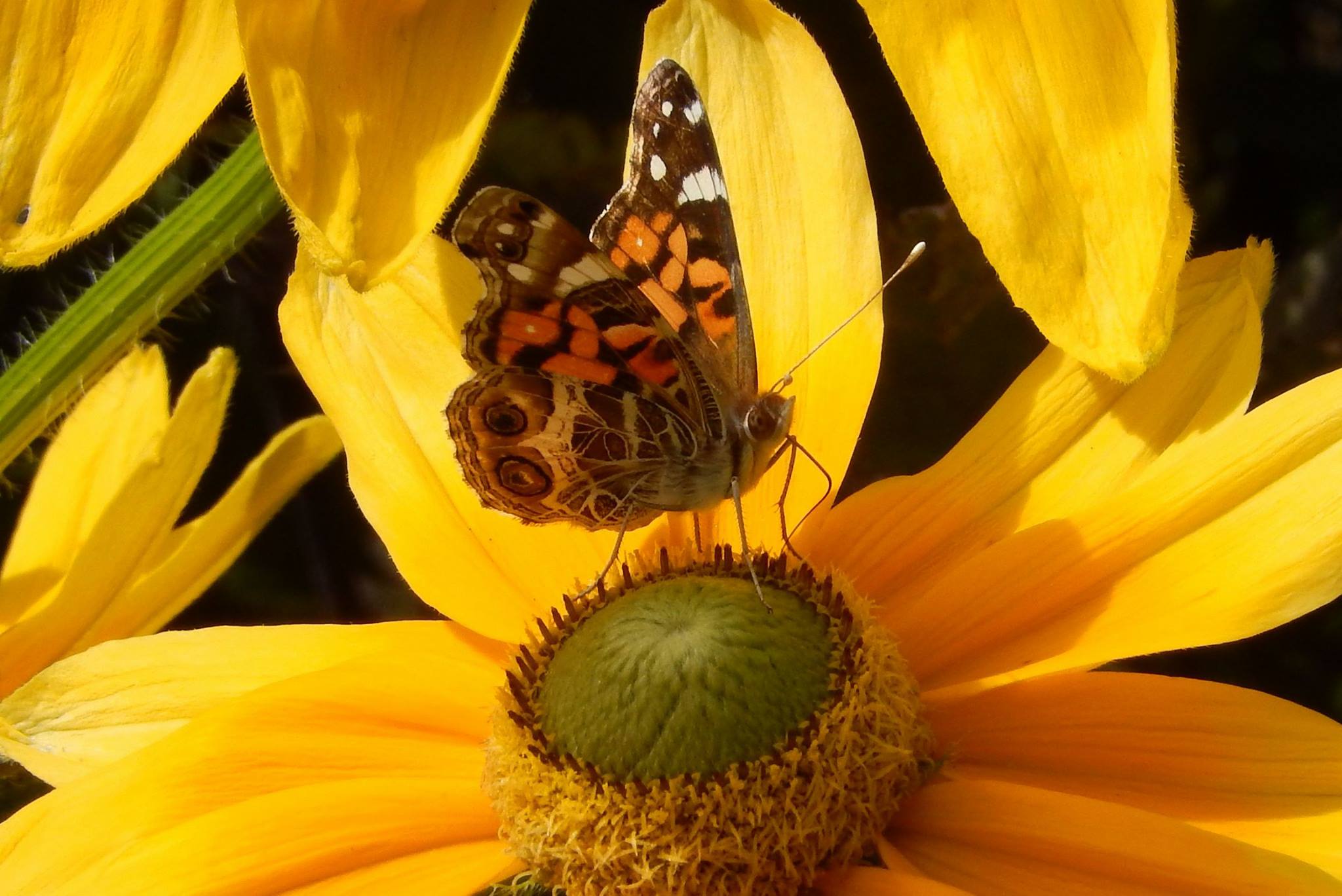
Maine Home Garden News — September 2017
- September Is the Month to . . .
- Leek Moth: A New Pest of Alliums in Maine
- New York Ironweed (Vernonia noveboracensis)
- In-Field and Farmers Market Gleaning
- Obsolete Pesticide Collection
- Food & Nutrition: Preserving Tomatoes
September Is the Month to . . .
By Lynne Holland, Community Education Assistant (Home Horticulture), UMaine Extension Androscoggin and Sagadahoc Counties
- Harvest the garden regularly. Donate excess produce through the Maine Harvest for Hunger program. For more information, please visit Maine Harvest for Hunger.
- Harvest and dry vegetables while they are at their peak. If you have been gathering vegetables regularly through the summer, mid September should be the last of the big harvests. Most vegetables require the use of a dehydrator. Find a friend and share the harvest as well as the dehydrator. Dried vegetables are great additions to soups and sauces throughout the winter.
- Stop watering and fertilizing any established perennials, trees, and shrubs in September. Watering and or fertilizing now will encourage new growth, making the plant susceptible to winter damage. Established perennial plants use this month to prepare for dormancy and winter.
- Remove plant debris and weeds from the garden to reduce the number of overwintering sites for unwanted insect and disease populations, and minimize the deposit of seeds into the soil “weed seed bank.” Follow with a cover crop to protect the soil and serve as competition for weeds. If planting a cover crop is not an option, top dress with an organic mulch, such as seaweed, straw or leaves. Mulch will also add nutrients to the soil and improve soil structure.
- Plan that new garden bed for next year. If you are considering a new garden space for next year now is the time clean that area out and do some sheet mulching or lasagna gardening to prepare the bed for planting in the spring. For more information, see Sheet Mulch — Lasagna Composting (PDF) from Oregon State University.
- Attack poison ivy with a vengeance. Dave Fuller, Agriculture and Non-Timber Forest Products Professional, UMaine Extension Franklin County, suggests the following steps for the best control of poison ivy:
- Spray with glyphosate just before poison ivy leaves start to change color — about September 1. Timing is everything. Why late summer? The plant is sending photosynthetic reserves down to the roots and a systemic herbicide will be better moved to the roots, as well. Don’t spray if rain is eminent.
- Wear garbage bags over your boots and pants, taped around the legs to avoid contact with urushiol, the offending compound in poison ivy. Turn bags inside out when removing for disposal.
- Follow the directions on the herbicide container. The label is the law.
- Watch the weather and take steps to protect tender plants if there’s a chance of frost. Bulletin #2752, Extending the Garden Season describes methods to protect plants from the cold and extend the growing season.
- Do a soil test. If the results indicate the need for lime and manure additions, September is a great time to apply those amendments. For more information on soil testing, see Bulletin #2286, Testing Your Soil. For safe manure practices, see Bulletin #2510, Guidelines for Using Manure on Vegetable Gardens. For more information on soil organic matter, see Bulletin #2288, Soil Organic Matter.
- Review the year. Which vegetables were high producers? What plant varieties were your favorites? List successes, failures, diseases, and insect pests. Brainstorm a plan for next season. Take pictures and add to an electronic garden journal or calendar. Pictures will help you remember the good and bad of the season.
- Save seeds of non-hybrids to plant next year. Learn how to have success saving seeds by reading Bulletin #2750, An Introduction to Seed Saving for the Home Gardener.
- Dig up bulbs that are not winter hardy like cannas, gladiolus, and dahlias after the foliage dies back. Clean the bulbs before storing. Store for the winter in peat moss or dry sand in a dark, cool, well ventilated space where the temperatures remain above 40 degrees Fahrenheit.
- Build raised beds now, so they will be ready to plant in early spring. For more information, watch our four-part video series Extending the Gardening Season Using Raised Beds. Includes a link to plans and materials list.
- Cut back on your lawn area and come over to the “Low Input Lawn” team. Reducing lawn area will save you time and effort next year. Starting to implement the practices of a “Low Input Lawn” now will help your soil recover over the winter so you can have a healthier lawn next year. See Bulletin #2166 Steps to a Low Input Lawn for detailed information.
Leek Moth: A New Pest of Alliums in Maine
By Dave Fuller, Agriculture and Non-Timber Forest Products Professional, UMaine Extension Franklin County
Leek moth (Acrolepiopsis assectella Zeller), a very destructive pest of all of the Allium family, was first found in Maine in the larval stage by the author on garlic plants at the Forest Hills Consolidated Schools garden on May 28, 2017. Cocoons were also found from which moths were reared and submitted to a USDA APHIS specialist in Maryland who made the confirmation of leek moth.
A detection trapping program was then initiated in early June in multiple locations in Maine by Cooperative Extension in collaboration with Karen Coluzzi of the Maine Department of Agriculture, Conservation and Forestry, Division of Animal and Plant Health. The object of the trapping was to determine where in Maine leek moths are found and to study its life cycle. Such information would be used to alert growers of the presence of leek moth and how to manage the pest. To date, Jackman is the only location in Maine where the moths have been found. Trapping will resume in the spring of 2018.
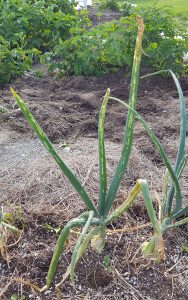
A native of Europe, leek moth first was seen in the United States in 2009 in New York and is now established in Vermont, New Hampshire and nearby in the Province of Quebec. Leek moth is so named for its affinity for leeks, but is attracted to all members of the allium family.
Damage to garlic and other allium leaves is done by leek moth caterpillars (larvae) and can be extensive, leading to diminished crops or possible crop failure. Damage on garlic in Maine has been seen mainly on the scape as it emerged, causing collapse of the structure. With onions, the larvae tunnel into the hollow leaves and feed on the inside surface causing a windowpane appearance. Mature larvae then exit the leaf and enter the pupal stage by spinning a loose “cargo net” cocoon.
Leek moths have 3 generations in Maine with damage to plants compounding as the season goes on as leek moth populations build. Each generation completes its life cycle from 30-50 days depending on the environment. Moths, larvae and cocoons are all very small, measuring about 3/8 of an inch long. Female moths lay from 100-200 eggs per generation over a two-week period starting in spring. Leek moths overwinter as adults or pupae in crop residue.
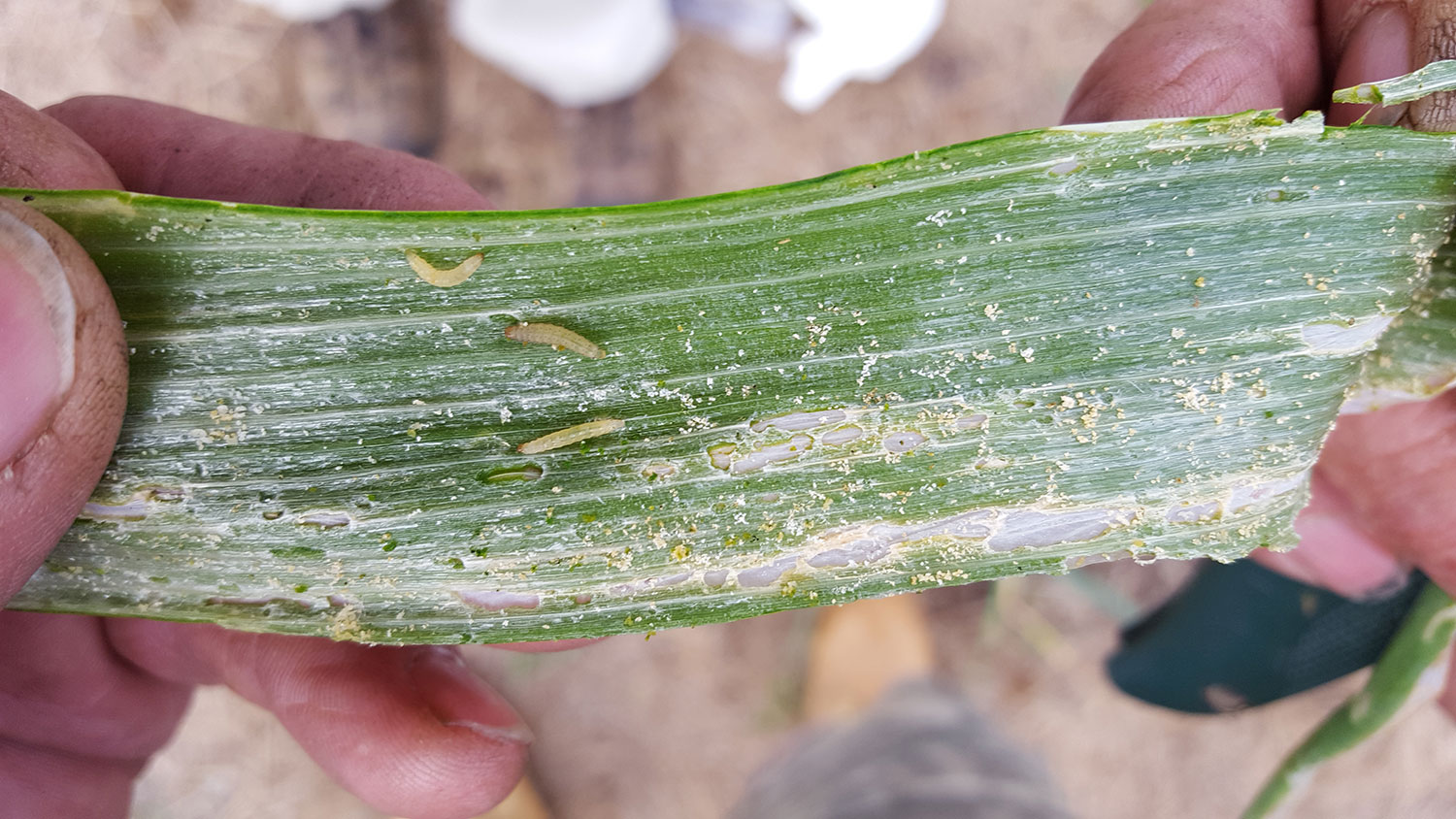
Control of leek moth is best accomplished by covering allium crops with a row over. Since the moths only fly at night, weeding and scape removal on garlic can be done during the day and covers replaced. Wire hoops would need to be used with onions as their tops would be damaged otherwise by wind-flapped row cover. There are no pesticides currently registered for leek moth in Maine. In other states, Bt is used, but timing is very important to be effective.
For more information, see Leek Moth (PDF), an excellent resource developed by Cornell University.
Please contact the author at dfuller@maine.edu if you have seen damage on your alliums similar to that pictured/described.
New York Ironweed (Vernonia noveboracensis)
By Liz Stanley, Community Education Assistant, Horticulture, UMaine Extension Knox & Lincoln Counties

Vernonia is a genus of about 1000 species of shrubs and forbs in the Asteraceae or Composite family. Plants in this very large family can be recognized by their inflorescence, which appear to be a single flower, but are actually a collection of flowers merged into a single head. Some species are known as ironweed.
New York ironweed is a tall native wildflower with deep purple clusters of finely petaled flowers that bloom in late August and September. The plant grows in airy clumps that can reach 8’ tall in wet swales, but can also grow in drier sites. Rough, pointed, serrate, lance-shaped leaves (6-8″ long) are similar to Joe-Pye weed but they’re alternate and more refined. The plant is easy to grow in full-sun (zones 5-9), and attracts many butterfly species, including Monarchs. The genus name, Vernonia, honors the 17th century English botanist William Vernon, who collected plants in Maryland. The species name noveboracensis describes the plant being “of New York” where it was probably first collected.
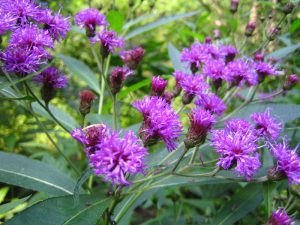
New York Ironweed is not attractive to deer, rarely needs staking, and is a beautiful background plant for rain gardens, pond sides, stream beds, native meadows and border gardens. It creates a strong upright companion for other tall species like yellow and orange Helenium (sneezeweed), Veronicastrum virginicum (Culver’s root), all colors of Echinacea (coneflower), Asclepias incarnata (swamp milkweed), and ornamental grasses.
In-Field and Farmers Market Gleaning
By Kate Garland, Horticultural Professional, UMaine Extension Penobscot County
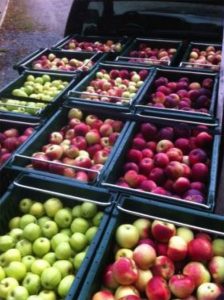
The USDA estimates that 15.8 percent of Maine households, or more than 209,000 individuals, are food insecure. Our state ranks 1st in New England and 9th in the nation for food insecurity. Meanwhile, Maine has 8,200 farming operations managing 1.45 million acres of land. A 2016 study by Shelburne Farms in neighboring Vermont estimated that 14.3 million pounds of wholesome vegetables and berries are lost each year in their state when food was not connected with people either by being purchased or donated by the producer. This study reported that every year, perfectly edible food is left in the field because of: blemished (edible) produce, farmers not confident they’d be able to sell, lack of available and/or affordable labor, and other reasons. No such estimates exist for food left in Maine fields, but there is no doubt it’s there and there’s a need to make an effort to capture these leaks in our food system.
Since 2000, University of Maine Cooperative Extension staff have been creating sustainable linkages between farms, volunteers, and food pantries/community meal sites. Statewide, our staff and volunteers currently support 49 gleaning sites and have gleaned close to 2.5 million pounds of food. Here are some of their stories.
In 2010, Hancock County Extension Hancock gathered hunger relief organizations to harvest surplus apples from a local orchard, starting a yearly tradition of gleaning and distributing an average of 5,000 pounds of apples to area food pantries and soup kitchens. In 2012, they partnered with Healthy Acadia and the city of Ellsworth to receive a grant to expand the Downeast Gleaning Initiative enabling them to hire a local gleaning coordinator and significantly increase their efforts to recover surplus crops from farms that would otherwise go to waste. Initially designed as a one year project, it’s now in its 6th season. Thanks to the hard work of two regional gleaning coordinators and over 200 community volunteers, many of whom are Master Gardener Volunteers, over 100,000lbs of fresh vegetables, fruits, and meats have been rescued and redistributed to neighbors in need.
Maine Gleaning Network (MGN) was launched in 2016 by Hannah Semmler, one of the Downeast Gleaning Initiative gleaning coordinators, as a way to increase communication among gleaning leaders throughout the state to share best practices and resources. The MGN offers networking opportunities to share and learn tips on how to improve safety, organization, and efficiency while also making procedures more seamlessly integrate into farm operations. Introductions to new online food sharing platforms such as Spoiler Alert and connections with innovative gleaning organizations such as Boston Area Gleaners have served as great professional development experiences.
In 2011, Penobscot County Cooperative Extension staff worked with a local farmer and volunteers to develop and implement a farmers’ market gleaning plan for the Orono farmers’ market. Tip sheets and market gleaning trainings have been offered throughout the state. Since then, at least 5 other markets in Maine have established programs that utilize volunteers and/or agency staff to collect and distribute unsold high-quality food to food security organizations. The past 6 years have yielded over 20,000lbs of donations from the Orono market alone. Farmers see this as a service and often bring extra food from their farm because they can count on the volunteers to bring it to where it’s most needed.
The first formal on-farm gleaning activities supported by UMaine Extension started in 2000 at Spiller Farm in York County when Extension had just begun promoting the national Plant a Row for the Hungry (PAR) initiative. A local Master Gardener Volunteer, and customer at the farm, was welcomed by the Spillers to harvest crops to donate to PAR (now known as Maine Harvest for Hunger). Soon, there was too much to harvest for the one volunteer so a team was organized to build an efficient system to respond to gleaning opportunities there. Gleaning leaders eventually set up a Tuesday/Thursday gleaning system and even organized food distribution agencies to pick up food directly from the farm, building an even more streamlined system of getting food into the community. “The Spillers have a real passion for the program; with annual donations totaling over 10,000lbs for many years running. This is an example of extreme generosity,” says Extension Educator Frank Wertheim.
These are just some of the many stories of how UMaine Extension is working to bring a professionalized service for farmers seeking to make donations of what is no longer of commercial value to them. Our producers work hard to grow this food; it’s important that it reach as many plates as possible.
Many volunteers and farmers are needed to continue making this program a success. Contact your local UMaine Extension county office to learn how you can help.
Obsolete Pesticide Collection
Each October, the Maine Board of Pesticides Control conducts a program to collect and properly dispose of banned and unusable pesticides from homeowners and farms. Preregistration is required and collections are held at four sites across the state.
Next collection will be in October 2017, one day each in Presque Isle, Bangor, Augusta, and Portland. Registration by September 22 is required; no drop-ins will be accepted. Find more information and use the forms found on this website.
Food & Nutrition: Preserving Tomatoes
By Kathy Savoie, MS, RD, Extension Educator, UMaine Extension Cumberland County
Let’s Preserve: Green Tomatoes
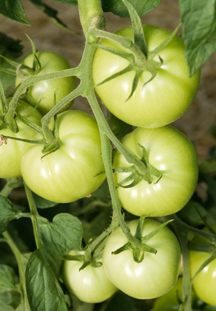
At the end of the growing season most home gardeners have loads of ripe and green tomatoes. They can be picked and managed so you have tomatoes and tomato-based products for the months to come.
Ripening Green Tomatoes
Select mature tomatoes that are green to slightly pink. They will ripen indoors in time if handled properly. First, remove the stem and dip each tomato in a solution made of household bleach mixed with water (add scant 1 tsp. bleach to 1 quart water). Dry each tomato off. This process will kill bacteria on the tomatoes which would cause them to spoil before they can ripen. Do not attempt to ripen green tomatoes from plants that are affected by disease, such as late blight. These tomatoes are not safe for canning, because the fungus can affect the pH of the fruit.
Sort according to ripeness. Spread newspapers in a carton. Place a layer of tomatoes in the box. Cover with another layer of newspapers. Close the box and keep at a temperature between 55°F and 70°F. At 65°F to 70°F, the tomatoes will ripen in about 2 weeks. At 55°F to 60°F, they will ripen in about 3 to 4 weeks. Be sure to check the tomatoes weekly for ripeness and to remove any spoiled fruit.
Let’s Preserve Tomatoes!
Using, Storing and Preserving Tomatoes
Keep ripe tomatoes at room temperature: above 55 degrees is recommended. Do not refrigerate under-ripe fruit. Tomatoes will ripen better out of sunlight. Once tomatoes are red and slightly soft, they will keep a day or two at room temperature. Refrigerate only if you want to keep them longer. For recipes using fresh tomatoes, see
- Bulletin #4178, Vegetables and Fruits for Health: Tomatoes
- Choosing, Storing & Using Fresh Produce: Tomatoes
With tomato season upon us, it is important for home canners to know that to ensure the safety of whole, crushed or juiced tomatoes, additional acid is needed whether you process them in a boiling water bath or pressure canner. To ensure safe acidity in whole, crushed or juiced tomatoes, add two tablespoons of bottled lemon juice or 1/2 teaspoon of citric acid per quart of tomatoes. For pints, use one tablespoon bottled lemon juice or 1/4 teaspoon citric acid. Add acid directly to the jars before filling with the product. Add sugar to offset acid taste, if desired. Four tablespoons of a 5% acidity vinegar per quart may be used instead of lemon juice or citric acid. For more information, see Bulletin #4085, Let’s Preserve Tomatoes.
Freezing tomatoes is a simple and quick way to preserve them. Learn how by watching our video on freezing tomatoes.
If you are looking to amp up your intake of local foods, preserving is a skill to learn to help extend your access to local foods year round. Check out our hands-on food preservation workshops.
Can I preserve tomatoes that have visible signs of late blight?
No. Late blight is a common disease in tomatoes and potatoes caused by the fungus Phytophthora infestans. The USDA Complete Guide to Home Canning (1994 ed.) recommends that canners select only disease-free, preferably vine-ripened, firm tomatoes for canning. The reason for this recommendation is that fungus infestation may raise the pH of the tomato flesh to a level that makes it unsafe for canning.
For more information, see Tomatoes and Potatoes Infected with Late Blight — Are They Safe for Canning? from Penn State Extension to help home canners understand the issue of late blight and home food preservation.
UPDATE for Home Canners
New Ball® Sure Tight™ Lids — 2017
The Ball® brand introduced new canning lids for 2017. These lids started appearing in stores where canning supplies are sold in May 2017. These lids are intended to replace all Ball® and Kerr® lids. Older lid supplies are safe to use and will be sold until they are gone. For more information, see Kansas State University’s informational flier (PDF).
University of Maine Cooperative Extension’s Maine Home Garden News is designed to equip home gardeners with practical, timely information.
Let us know if you would like to be notified when new issues are posted. To receive e-mail notifications fill out our online form.
For more information or questions, contact Kate Garland at katherine.garland@maine.edu or 1.800.287.1485 (in Maine).
Visit our Archives to see past issues.
Maine Home Garden News was created in response to a continued increase in requests for information on gardening and includes timely and seasonal tips, as well as research-based articles on all aspects of gardening. Articles are written by UMaine Extension specialists, educators, and horticulture professionals, as well as Master Gardener Volunteers from around Maine, with Katherine Garland, UMaine Extension Horticulturalist in Penobscot County, serving as editor.
Information in this publication is provided purely for educational purposes. No responsibility is assumed for any problems associated with the use of products or services mentioned. No endorsement of products or companies is intended, nor is criticism of unnamed products or companies implied.
© 2017
Call 800.287.0274 (in Maine), or 207.581.3188, for information on publications and program offerings from University of Maine Cooperative Extension, or visit extension.umaine.edu.
